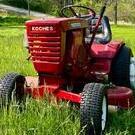-
Similar Content
-
 By WheelPuke
By WheelPuke
I have my 25A fuse blowing every time I put a new one in the slot. The old one was burnt up when I got the tractor put this year. It sat for a year with a dead battery. I stopped using it as much because the transmission is clattering pretty bad when taking off on second or higher. I had to replace the clutch belt a few years ago and couldn't get an OEM. Not sure what is the problem there that's another issue though.
I have checked the wiring and patched the worn spots where it could be grounding out. The fuse blows as soon as there is power to the system with the ignition off. I'm at a loss of what to check for at this point. Any input from someone who has had this issue would be appreciated. I'm not sure what these units are in the photos but do not know how to test them for a failure. They are directly in loop with the battery and the ignition loom looks to run into that 25A fuse.
-
 By BrianKoch
By BrianKoch
Hello gentleman,
Problem: will not crank on its own, will crank with jump box—but still not fire
Recent things I did prior to this issue: cleaned fuel filter, replaced battery cables, replaced cable from ignition to starter
I have my test light out and am probing around.
There is no power at ignition/magneto wire or the ignition/starter wire
There is power everywhere else
-
 By Jeff-C175
By Jeff-C175
Detailed wiring from the Demystification Guide #492-4509
4 pages 1.4MB Color
p7-67 to p7-70
Onan powered
1989 416-8 model 31-16O801
-
 By trident
By trident
Need some help. My 800 Special has an electric PTO. It is not working. Checked Ohms - nothing. My questions are 1) how does the PTO come off and 2) can they be rebuilt? I took the bolt out that I thought holds it on but no luck. Must be something more?
-
 By grasscuts
By grasscuts
Hi, here's what happened. I changed out 9 pin moles plug...had issues tracter quit running and changed the plugs while I was at it....got plugs from auto store cross reference to ngk they said it was the same heat range and I check electrod length with calipers ,same...tracter started right up and ran great for about 10 min. And started back firing and quit.....going to check it out tonite anybody have an idea?
-

